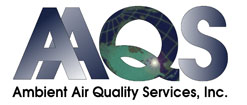|
Landfill Meteorological Performance Audits
Typically, onsite monitoring audits should be performed within 30 days of system startup and on a bi-annual basis (once every six months).
The performance audit should challenge the meteorological sensors with known values or compare sensor responses with values from sensors with a known accuracy. All audit devices should be traceable to National Institute of Standards and Technology (NIST) standards whenever possible. AAQS sends its audit equipment for re-certification and re-calibration on an annual basis. Each AAQS performance audit will include the following audit techniques:
- A wind speed motor will generate known rpms to compare horizontal wind speed responses. The wind speed motor is attached to the sensor shaft and is driven with at least three known rates of rotation until the data-logging system stabilizes.
- A torque wheel will be used to determine starting torque for wind speed and direction. This test is performed using a torque wheel or similar device.
- A linearity test fixture will test the linearity of the wind direction sensor. This is accomplished by holding the vane in positions with known angles.
- A sighting scope, field compass and/or USGS map will be used to check the crossarm alignment for true north, true south, true east, or true west. It is important that the sensor is aligned to “True” direction. For example, in eastern Pennsylvania, one landfill AAQS performs audits for has a True north (adjusted for magnetic declination) of 11 degrees and 51 minutes. Aligning the sensor to magnetic north (0 or 360 degrees) would be incorrect without the adjustment of the data for the 12 degrees of magnetic declination.
- An ice bath, ambient bath and a traceable temperature probe will be used to check the response of the ambient temperature sensors. This can only be preformed with a sensor capable of being immersed in ice and warm water baths. If the sensor cannot be immersed, a sensor is collocated, and a general temperature comparison will be performed during the audit period.
- A traceable barometer will be used to audit the barometric pressure sensor.
- A solar radiation sensor or net radiation sensor will be compared using a calibrated traceable sensor to compare site values with the audit values.
- A graduated cylinder or some other measurement device will be used to audit the tipping bucket rain gauge. This is accomplished by measuring a known amount of water by the site rain gauge.
|
